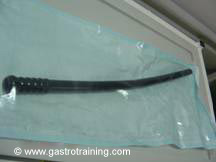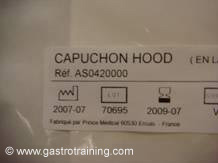Endoscopic treatment of foreign body in upper GI tract
The module covers:
- How to determine the location of the foreign body
- How urgently the endoscopy needs to be done
- How to use an overtube
- How to grab the FB
- When can you wait and watch
- Food bolus obstruction
Location of the foreign body:
- Two important questions-What is it and Where is it ( Pharynx/Larynx/trachea/oesophagus etc)
- Take history and get an x-ray of neck/CXR /AXR depending on the history and clinical suspicion
- Remember -Bones may not show on x-ray
- Get both coronal and sagittal views- if in doubt
- Beware of airway compromise
How urgent is the need for an endoscopy?
- Immediate if
- Complete obstruction
- Sharp – up to 35% perforate
- Battery – burn within 2 hours and can perforate within 6 hours
- Everything else within 24hours
- Use overtube- prevents repeated intubation and protect airway and mucosa
- Thoroughly lubricate the inside and the outside of the overtube
- Pass the endoscope through the overtube- the thicker and corrugated end remains outside the oral cavity – then intubate and advance the gastroscope
- Keep the tip of the overtube in the lower oesophagus while you find the foreign body as it immediately deflates the stomach and view will be compromised
- Once FB is viewed and position located – do a J manoeuvre and advance the overtube – note the tip protruding through the GOJ- both overtube and the scope is black but scope has got white ring marking
- Next withdraw the overtube just within the GOJ and inflate the stomach again
- Find the foreign body and grasp it – use Roth net for battery, for razor blade use stent grabber- anything sharp – you need to grab it along its axis and not across
- Pull the scope very close to GOJ
- Advance the overtube OVER the scope to cover the sharp object – we find it more convenient than to pull the scope into the overtube
- Immediately the whole field will look black
- Withdraw the endoscope and FB together keeping the overtube in place
- Can go back again if more FB is to be picked
- Remove the overtube at the end

Picture1: An overtube
How to use and overtube
How to grab the FB
- Tool kit- snare/triprongs/Roth net/Suction cap/biliary basket/Rat toothed forceps
- Capuchon hood is another device which can be used instead of overtube in selected cases- it is fitted at the tip of the endoscope and looks like a rubber skirt which invaginates itself once the scope is withdrawn into the GOJ and then covers the FB
- Dry run outside the patient with similar objects- ensure the size of the FB is compatible with the holding size of your device
- Move with pointed end trailing
- If both ends pointed cover one with forceps
- For razor blades rat toothed forceps ( stent grabbers) are probably best as with other devices you can catch it across which is problematic
- If perforation- conservative management only in highly selected cases (endoclips or covered stents)- most require operation

Picture2: Capuchon hood
When can you wait and watch
- If the patient is
- Asymptomatic
- Blunt FB
- Inert FB
- Not>5cm
- Healthy gut
- Warn to report symptoms
- Check X-Ray
Food bolus obstruction:
- If complete obstruction with saliva drooling urgent OGD
- Once visualised one can either
- Pull- Forceps/snare/net/grasper
- Push it down in to the stomach by using
- Air insufflations
- Gentle pressure
- Fragment and gentle pressure
- Success 97%
- Remember to take oesophageal biopsy particularly if young male to exclude Eosinophilic oesophagitis
- If narrowing is seen once the bolus is gone- e.g. benign stricture, web, schatzki’s ring or malignant stricture – that needs to be addressed then or later depending on the pathology.
Here is the link for foreign body extraction video:
Acknowledgement/Bibliography:
- Alhaji M et al. Razor blade removal from the stomach utilizing a novel modification of the overtube. Endoscopy. 2009;41 Suppl 2:E166. Epub 2009 Jul 23.
- Webb WA et al.Management of foreign bodies of the upper gastrointestinal tract. Gastroenterology. 1988 Jan;94(1):204-16.
- Stack LB et al. Foreign bodies in the gastrointestinal tract. Emerg Med Clin North Am. 1996 Aug;14(3):493-521.








